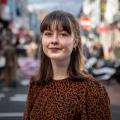
A council has defended spending £25,000 on a new piece of neon artwork to light up a historic Brighton structure.
Brighton and Hove City Council revealed the Electric Garden at Madeira Terrace during Wednesday night’s Burning the Clocks event.
Sussex artist Andy Doig, who set up his design studio on Madeira Drive in 1995, said he was inspired by what grows beneath the arches of Madeira Terrace for the piece.
A garden made up of sculpted glass tubes designed to echo and highlight the existing plant growth, the work will be lit between 4pm and 10pm every day.
Each tube has been made entirely by hand from recycled glass at the artist’s studio.
But some residents have remarked on the cost of the artwork and said the money should have been “put to better use”.
Brighton and Hove City Council said the work has already made a big difference to the terrace, which is due to undergo restoration work next autumn.
They said the artwork is “good value for money” and will attract more residents and visitors to the area over the winter months.
A council spokesman said: “The illumination of even just the few arches has made a real difference to how that part of the seafront feels at night.
“The new low-energy lighting has given it a different atmosphere.
“Madeira Drive has some brilliant businesses and is already a popular destination in the summer months. This lighting “event” is designed to enhance and brighten up the area for residents who walk this route regularly during the winter months.
“Along with the restoration of the terrace, it is a step towards it becoming a year-round destination in future.
“The lighting is designed to be reused over a five-year period, during future phases of the Madeira Terrace restoration or elsewhere in the city.
“The £25,000 upfront cost comes out as £5,000 per year over the five-year period. We believe this is really good value for money.
“It is now a well-accepted principle of urban design that public art contributes to a community's identity, fosters community pride and a sense of belonging.”
The council said the commission forms part of a new art programme for the Terrace called Otherworlds.
The first part of the programme invited lighting artists to consider the site in relation to the “otherworldly” plant habitat that has grown there over the last 150 years, and to provide soft lighting to illuminate the area for the winter months.
When the dark nights are over it will be retained and used again in other parts of the terrace, the council said.
Otherworlds… is the latest work resulting from the council’s public art strategy, which was launched in April, and marks the first phase of the terrace’s restoration.



Comments: Our rules
We want our comments to be a lively and valuable part of our community - a place where readers can debate and engage with the most important local issues. The ability to comment on our stories is a privilege, not a right, however, and that privilege may be withdrawn if it is abused or misused.
Please report any comments that break our rules.
Read the rules hereLast Updated:
Report this comment Cancel